Battle of Tolbiac facts for kids
Quick facts for kids Battle of Tolbiac |
|||||||
|---|---|---|---|---|---|---|---|
 "The Battle of Tolbiac" by Ary Scheffer. Galerie des Batailles |
|||||||
|
|||||||
| Belligerents | |||||||
| Franks | Alemanni | ||||||
| Commanders and leaders | |||||||
| Sigobert the Lame Clovis I Aurelianus |
Gibuld † | ||||||
| Strength | |||||||
| 6,000 Franks | Unknown | ||||||
| Casualties and losses | |||||||
| Heavy | Heavy | ||||||
The Battle of Tolbiac was a very important fight between two groups of people: the Franks and the Alamanni. The Franks were led by their king, Clovis I. We don't know who led the Alamanni in this battle.
Historians usually say the battle happened in 496 AD. However, some think it might have been earlier, around the 480s or early 490s, or even later, in 506 AD. The battle took place near a place called "Tolbiac," which is now Zülpich in North Rhine-Westphalia, Germany. This area is about 60 kilometers (37 miles) east of the modern border between Germany and Belgium. The Franks won the battle, which made them the main power over the Alamanni.
Contents
Why They Fought
The Franks were actually two groups who were allies. One group was the Salian Franks, led by King Clovis. The other group was the Ripuarian Franks, whose capital city was Cologne. Their king was Sigebert the Lame.
Next to Sigebert's kingdom lived the Alamanni. They were a group of Germanic tribes. Over time, there were many small fights and raids between the Alamanni and the Ripuarian Franks. In 496 AD, the Alamanni launched a big attack on Sigebert's kingdom. Sigebert asked his ally, Clovis, for help. Clovis agreed and gathered his army to fight. It's believed that Sigebert and his army suffered many losses defending Tolbiac. Some historians even think there might have been two battles at Tolbiac.
The Battle and Clovis's Prayer
We don't know many details about the battle itself. It seems the Ripuarian Franks might not have been able to help much after the first part of the fight. Clovis saw his soldiers falling and felt like his army was losing control.
He became very upset and started to cry. He then prayed to the God of his wife, Clotilde. She had been telling him about her Christian God since they got married in 493 AD. Clovis asked for this God's help.
A historian named Gregory of Tours wrote down Clovis's prayer. Clovis said, "O Jesus Christ, my wife Clotilde says you are the son of the Living God. You help those in danger and give victory to those who trust in you. I need your help to win this battle. If you give me victory over these enemies, and if I see the amazing things people say happen because of your name, then I will believe in you. I will also be baptized in your name. I have called on my own gods, but they have not helped me. This makes me think they have no power. Now I call on you, and I want to believe in you if you can save me from my enemies."
Right after Clovis said this, the Alamanni started to run away. Their leader was killed with an axe. The Franks then defeated or killed the rest of the Alamanni.
Clovis Becomes a Christian
Gregory of Tours was the first to say that Clovis won because of a promise he made. Clovis promised that if he won, he would convert to the Christian religion. He kept his promise and became a Christian. He was baptized in a ceremony at Reims on Christmas Day in 496 AD.
The traditional date of the Battle of Tolbiac (496 AD) fits with this baptism date. A letter from a bishop named Avitus of Vienne congratulated Clovis on his baptism. However, this letter does not mention that Clovis converted on the battlefield.
What Happened After the Battle
After their defeat, the Alamanni left the Lower Rhine area. This meant the Ripuarian Franks were safe. Clovis didn't take much land for himself. He let his ally, Sigebert, keep his territory. Later, Clovis relied on Sigebert's help when he conquered the northern part of the Visigothic kingdom.
Another very important result was Clovis's conversion to Catholicism. He was baptized by Bishop Remigius of Rheims. This conversion brought him the support of other Christians nearby. It also gave him the support of powerful church leaders. Because he was now a Christian, Clovis could lead his armies to conquer new lands. He could also fight against groups who were considered heretics by the church.
When Did It Happen?
The traditional date for the battle is 496 AD. However, some historians, like Augustine Van de Vyver, have suggested it happened later, in 506 AD. This idea has been discussed a lot. Some modern accounts follow the 506 AD date. This later date also fits with Gregory of Tours' timeline. He said Clovis's father, Childeric I, died around the same time as Saint Perpetuus, who died in 491 AD. So, 15 years after 491 would be 506. Coins found in Childeric's grave were from Emperor Zeno, who died in 491, but there were no coins from after that year.
Images for kids


